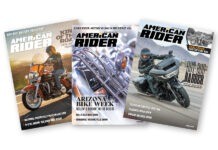Dual Clutch Transmissions are already available from the other motorcycle company whose name begins with (a big red) “H.” Optional on the Honda NC700 series and the big VFR1200, this is a first for two-wheelers, although they’ve been offered in high-end cars (mostly German) for several years now. Continuously Variable Transmissions are available on the Aprilia Nano 850, and that concept (which is embodied in a bazillion scooters globally) also comes from car tech. Very Important Progress/Product (even if that’s not what VIP usually means) as far as I’m concerned! As Soon As Possible… Harley-Davidson needs to offer comparable technology in its model lineup. Laugh Out Loud if you want, but there’s solid evidence that this kind of “shift it yourself—or not” gearbox might very well wind up being the biggest thing in motorcycles since the electric starter. What’s Technology For… if not to improve certain functions and capabilities that make life and its various activities better, easier, safer and more fun? Our favorite activity… motorcycling… is no different.
Come on, admit it: you haven’t been driving a stick shift car for years now… have you? You’re not alone! A 2013 EPA report shows that 3.9 percent of the trucks and 9.1 percent of the cars sold last year had manual transmissions, compared to 45.8 percent and 19.9 percent, respectively, 20 years ago. Clearly, manual transmissions in cars are on life support. Longtime advocates of three-pedal cars and trucks have always argued that the big deal was “control”—i.e., they could hold the engine in any gear as long (or short) a time as they wanted or (allegedly) needed to get the job done. The truth of this is eminently arguable. The fact of it results in many a blown engine, duff clutch or other forms of mechanical mayhem by virtue of the inability of many a rider/driver to coordinate the process well enough, or to exercise proper judgment about what gear to do what with… when. Add the multiplicity of ratios, as many as seven or eight in modern cars, and the time it takes to actually let a human do the shifting, and you have a recipe for lack of control. Think further in regards to the paucity of choices in automobiles that offer a manual gearbox these days. Hell, as we speak, Ferrari doesn’t even have one. Corvette, another longtime enthusiast’s dream, only sells about one in nine “manny trannys” these days… a long ways from the days when most buyers wanted to “stick” to it in a sports car of any stripe, and over half of all ’Vettes built sported manual gearboxes. Point being, even among high-end unaffordable exotics that offer them, actual usage of a clutch and gear lever is down… way down! At the other end of the spectrum are the bargain-basement econo-boxes, where rowing gears is supposed to be part of perhaps a 2-mpg advantage over a conventional automatic and touted as being among the “joys” of ownership. In between these opposite poles, pickin’s are even slimmer. Mostly because the onslaught of electronic engine management and its resultant slick tricks with shifting have made a manual tranny essentially redundant. Well, that and the somewhat scary softening of America that indicates its presence with the reality that most Millennials (anybody under 40, really) never learned to drive a stick! It’s a dying art… simple as that.
CAPTION: As you can see, DCT has dual clutches for sure, but also dual (inner and outer) mainshafts. The essence of the idea is that, for all intents and purposes, whatever gear you are already in, the next one has been “pre-selected” and is ready to engage in a nanosecond. You can do that manually via a button or “trigger”-type lever on the handlebar or…
CAPTION: ..let the ECM on the motorcycle figure it all out for you and shift itself using a special purpose “shift control” motor, such as the one you see here.
To you and me and our talented left foot, all this must seem a pity… or irrelevant. We’ll get along famously as we have for generations, shifting for ourselves, won’t we? Well, maybe so and maybe no! Although, thanks to the invention and rapid adoption of the shifter return mechanism by Harold Willis (of Velocette) 70-some years ago, motorcycles have been much easier to shift than cars. (Excepting tank-shift bikes from the Dark Ages.) Be that as it may, for reasons much like those in the automotive world—it just isn’t the best way anymore. As we age, coordination and reflexes tend to slip up and slow down. Even remembering (or guessing) which gear is best for this or that curve, climb or descent, can put us out of shape (or in danger) in a split second on a ride. Oh… and one other thing… no matter how handy you are at tap dancing on a shifter, each one of ’em takes at least a half a second to accomplish. ABS brakes work faster than that, so why shouldn’t your transmission?
Well, traditional automatics have been tried in motorcycles before, haven’t they? Moto Guzzi had the V1000 “Convert,” Honda tried a CB750A (no prize for guessing what the “A” stood for) back in the 70’s and both companies wound up with warehouses full of leftovers… a.k.a. unsellable slugs! Automatic transmissions are far too unwieldy, slow acting, bulky, heavy and plain ol’ weird to ever be the hot-tip trans in a two-wheeler. That said, you’ve gotta appreciate the motives behind a “shifts itself” motorcycle. Safety, for one. Fewer things to deal with as you ride, or even just to take a ride, means the ability to focus on more important matters… like what the hell that Buick thinks it’s up to up ahead. Automatic shifting also makes learning to ride a lot easier. None of that pesky “release the clutch slowly while giving the engine a little throttle” crap to master. (You might miss seeing the hilarious results of getting it wrong on AFV, but no one misses the damage and danger in real life.) So, what would it be like to combine the advantages of an “automatic” transmission with the sporting (and literally superhuman) prowess of computer-controlled “smart” gearboxes? (Which, by the way, can be overridden by the “master” of the machine, should it be so desired.) In other words, how nice would it be to have literally all the advantages of both and none of the downsides of either? Would shift speeds twice as fast as humanly possible be putting frosting on the cake? Seem like a good idea? That… is precisely where Dual Clutch Transmissions (DCT) and Continously Variable Transmissions (CVT) come in!
CAPTION: Another way to go is even simpler… no gears! Instead, a system of variable pulleys and a high-tech “belt” that are in constant motion to keep you moving. Original versions (mostly from scooters beginning decades back) used the physics of centrifugal force, but nowadays that function is managed by computers onboard the bike.
DCT’s, as the name implies, feature two clutches, the advantage of which is that it allows the computer to have the next gear (up or down) ready to go… before you need it. Algorithms based on variables (road speed, deceleration and/or acceleration, load, engine rpm and a buttload of others) give the gearbox a better sense of what to do next than the average human. This it then does slickly, seamlessly, constantly, without error or worry to the rider… in nanoseconds. You want to play, you say? No problem… just hit a button or trigger on the handlebar and the box shifts when you wish it (right or wrong) more quickly than pulling one lever and tapping another ever could. Sporty indeed if you insist! If not, you can forget about it and just enjoy cruisin’ through the scenery… a lot like you’ve probably been doing for years in your car. (By the way, Honda’s so-optioned models have neither clutch nor foot levers.)
CVT’s actually take things a hair further into the future by borrowing a page from the past. Namely (at its simplest), the use of pulleys of different sizes and spacing rather than a wad of cogs. Left to themselves (meaning constantly variable indeed), they don’t actually shift from one gear to another at all! Initially a pretty eerie experience, the smooth function of sliding belt and pulleys soon makes you realize the vehicle is always in the “right gear” that way! The kinda sci-fi aspect of it is that when you choose to “shift” it yourself, the button/trigger you touch on the bars simulates a gear. (In the case if the Aprilia Nano 850, seven of ’em!)
CAPTION: Inside an Aprilia Nano we see how a CVT layout looks in the metal. Without conventional clutch or cogs to bang and jerk around, the totally shift-less transfer of power from engine to rear wheel is uncanny. It’s an elegant, sophisticated mechanism… figures it was first penciled out way back in 1490 by none other than Leonardo da Vinci!
Since the incorporation of either of these types of 21st century trannys would extend the motorcycling “life” of aging riders, offer more worry-free entry into Harley-world by tyros and more, I do not understand why H-D isn’t in hot pursuit of adding them to its model offerings—as an option on its line of Big Twins in particular… and ASAP! (Unless they actually are and just haven’t told anybody yet.)
The Motor Company has recently proven its desire to compete in a global market with the introduction of the Street 500 and 750. But it also has a long history of being conservative and traditional. There would appear to be a dynamic tension there. It has worked to their advantage in the past to wait and see how competitors fare with “new” ideas before they go out on that limb. Yet they also claim to listen closely to their customers. Harley shouldn’t “automatically” rule out a quantum leap in transmission technology in order to shift for themselves… and neither should you! Because it seems clear to me that adopting CVT or DCT is destined to be an advantage for both Harley and its customers. Rather than being an answer to a question nobody asked (like too much of what passes for progress these days), an abundance of definable need is the hallmark of a true game changer… or gear changer, for that matter.
























Thank God I’ve already got mine….
1992 FXRS- Evo engine- five speed MANUAL transmission
Also-
1989 Chevrolet K1500- 350 V8- five speed MANUAL transmission
Amazingly, it’s become harder to find a decent mechanic for the pickup than for the bike!